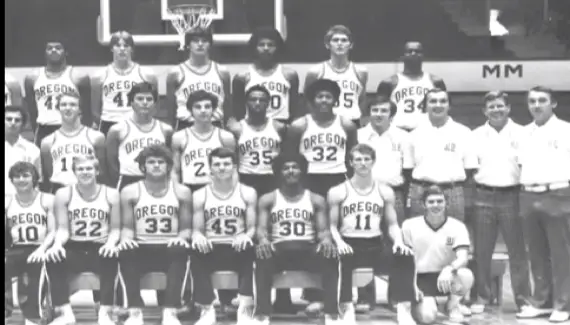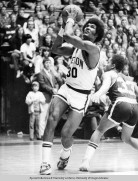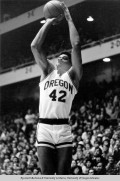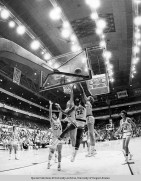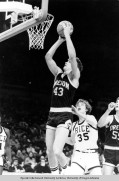Following Oregon’s disastrous 1971-72 season, Dick Harter was finally able to land his first outstanding recruiting class that included guard Ronnie Lee, guard/forward Mark Barwig, forward/center Bruce Coldren, and center Geoff Nelson. Along with the holdovers from Harter’s 1971-72 team, five sophomores from the 1971-72 freshman team, and three walk-ons, the four freshmen would form the original version of the Kamikaze kids.
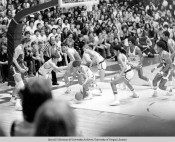
Bruce Coldren and Gerald Willett
Courtesy University of Oregon Libraries, Special Collections & University Archives
The forwards that year included Barwig, Ken Stringer, Doug “Cowboy” Little, Billy Ingram, Kim Swain, Bob Catchings, and George Martin. Coldren played both center and forward. Centers were Gerald Willett and Geoff Nelson. The guard corps included Lee, Bert Frederickson, Paul Halupa, Walt Reynolds, and Dean Roberts. The usual starters on this team were Lee, Barwig, Willett, Little, and Coldren, with Barwig able to play both forward and guard.
The Ducks opened the 1972-73 season with a blowout win over Portland University. The following night Oregon was to meet a highly-ranked Wichita State team at McArthur Court. The Shockers were heavily favored to win, however, Oregon, behind the play of Lee and Barwig, upset Wichita State, 92-72. Harry Miller, Wichita State’s head coach was furious. He found blame with everyone from the PAC-8 officials on down.
More importantly he was upset about Oregon’s style of playing. Miller claimed that the Ducks were more aggressive than Kamikaze pilots during World War II. He claimed to have never seen a basketball team attack like the Ducks did. According to Miller, Oregon’s playing style would set basketball back 25 or 30 years, and result in a game that no one could be proud of.
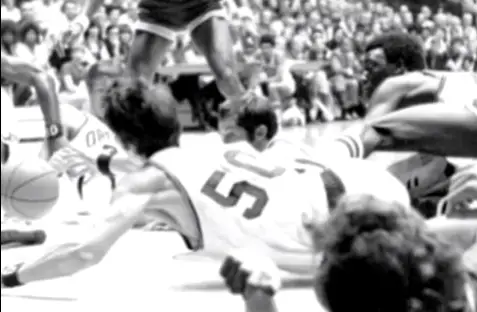
Diving for the ball.
While Miller did not coin the nickname “Kamikaze Kids,” his comments clearly led to the nickname. Who coined the nickname “Kamikaze Kids?” Perhaps we will never know for sure, but it appears that Harter, who hated the nickname “Ducks,” coined the term and asked the media to refer to his team as the Kamikaze Kids.
The nickname stuck. The 1972-73 season would also be the beginning of six consecutive seasons of home game sellouts that would only end with Oregon’s first losing season under Jim Haney in 1978-79.
Oregon finished the 1972-73 season with a record of 16-10, including eight PAC-8 victories. The stage was now set for Harter’s second outstanding recruiting class. The 1973 class would bring in guard/forward Ernie Kent, forward Stu Jackson, guard Greg Graham, forward Greg Ballard, and center Steve Manker.
Kent, Graham, and Ballard became key components of the Kamikaze Kids for the next four seasons. Manker, one of the few rally big men Harter recruited, would quit the team in January 1974. Apparently, Manker decided that he was strictly an offensive player and did not fit into Harter’s style of play.
Jackson would play three seasons for the Ducks before suffering a severe knee injury in an motorcycle accident. The injury, along with disagreements with Harter, resulted in Jackson’s transfer to Seattle University, where he finished his playing career.
Other members of the 1973-74 team included Halupa, Nelson, Lee, Frederickson, Coldren, Barwig, Swain, and Stringer. The 1973-74 team finished with a 15-11 record, with the biggest victory that season being the upset of defending NCAA champion UCLA, at Mac Court. The Bruins had lost the previous night to Oregon State, and Oregon had been beaten badly by USC. Prior to the start of the game, the Oregon pep band played the OSU fight song as the Bruins warmed up, and Don Essig, the Duck PA man, announced the Bruins as the “descending national champions.”

Dick Harter
The crowd was getting raucous and the scoreboard, hanging by four cables from high in MacArthur Court, was swaying because of the vibrations emanated from a jumping, stomping crowd. Coming off the loss to USC, Harter decided to shake up his starting lineup by benching Frederickson and Jackson in favor of Barwig and Coldren. The starters played all but five minutes of the game, with Coldren being the star, scoring 24 points in a 56-51 victory.
Harter’s 1974 recruiting class was far less successful than the two previous classes. Only guards Mike Drummond and Rob Closs would spend their entire playing careers at Oregon. The big men recruited that year, Randy McCoy, Frank Rourke, and Ted Mancini were all gone within two years.
It would be the 1974-75 team that got to Oregon’s first post season tournament since the 1960-61 team, with guards Lee and Barwig, forwards Ballard and Jackson, and center Willett as the primary starters. The 1974-75 season opened with a streaker wearing nothing but a green and yellow stocking cap running around Mac Court. However, Oregon had done well enough during the regular season to earn a bid to the National Invitational Tournament. The Ducks opened the NIT with a victory over St. Peter’s, followed by a victory over Oral Roberts.
That set the stage for the semifinal game against Princeton. Oregon was favored and should have won. Princeton, however, played great defense, while Oregon could never get untracked offensively, and there were several questionable calls that went against Oregon late in the game, as Princeton won, 58-57. Harter would later recall this game as being his most bitter loss. The Ducks would rebound the next day to beat St. John’s for third place. Most observers felt Oregon was the best team despite the loss to Princeton. Lee was named the tournament’s Most Valuable Player, and Oregon finished the season 21-9.
Harter continued his search for a big man to play center with the graduation of Willett. In 1976, he recruited center Dan Hartshorne, forward Danny Mack, forward Joe Moreck, forward/center Kelvin Small, and center Gary Nelson. Only Small would play four years for Oregon.
Hartshorne played three years, missing the 1976-77 season as a result of injuries suffered in a logging accident. Mack would play three years but eventually leave the team as a result of academic problems. Moreck was kicked off the team during his junior year after missing a practice. Nelson would quit after his sophomore year to concentrate on his studies.
The 1975-76 team featured starters Lee, Barwig, Hartshorne, Ballard and Jackson. The supporting cast included Drummond, Graham, Coldren, Mack, Moreck, Geoff Nelson, Gary Nelson, and Small. There were back-to-back highlights and lowlights during the season.
The highlight came on February 21, 1976 when Oregon beat the Bruins by 20 points on the Bruins home court, ending UCLA’s 98 game home winning streak. Oregon fans went crazy over the victory.
The next week would bring the hated Washington Huskies to Mac Court. At stake was a probable NCAA bid for the victor. The fans were pumped for this game. The Pit was rocking. Frisbees flew from the stands. One fan dressed as the Lone Ranger paraded around the court on a stick horse to the William Tell overture to the delight of fans.
It was Harter’s practice to have some of his players line up at mid-court and stare at the opposing team as they went through their warm up drills. This was intended to intimidate the opponent. However, the Huskies were prepared to respond this time, as several of their players came onto the court and placed themselves in front of the Ducks and donned Groucho Marx glasses. The crowd thought it was funny.
We cannot be sure of the impact on the Oregon players, but the Ducks did go on to lose the game, 67-62. While finishing the season in second place, the Ducks were not selected for the NCAA tournament. The Huskies got the bid based on a better season record. Oregon did return to the NIT, only to lose its opening game to North Carolina-Charlotte. With this loss, Oregon finished the season 19-11.
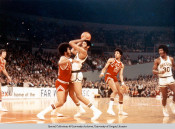
Greg Ballard & Ronnie Lee
Courtesy of University of Oregon Libraries, Special Collections & University Archives
The NIT loss would be the final game for Lee, Barwig, Coldren, and Geoff Nelson. Lee would leave being considered the greatest player in Oregon history.
Harter now had to replenish his team. The 1976 recruiting class yielded only three players. forward Earl Williams, and guards Beau McCloud and John Murray. Williams and McCloud would be gone after their freshman season. Murray would play four seasons for the Ducks.
Ballard was the undisputed star of this team. The other starters were Kent at forward, Small at center, and Drummond and Murray at the guards. Other team members were Moreck, Closs, Mack, Graham, Gary Nelson, McCloud, Williams, Mike Greig, Rick Cornish, Greg Brown. Despite the loss of four starters from the 1975-76 team, Oregon managed a 19-10 record, and its final NIT appearance. The Ducks won their first game with a one-point victory over Oral Roberts, but lost a close game to St. Bonaventure, to end the season. Now the 1973 recruiting class was done.
Harter’s 1977 recruiting class was one that he felt was his best. It included guard Stu Lyon, forward Phil Barner, center Rich Davis, forward Mike Clark, and forward Felton Sealey. Only Clark and Sealey would finish their playing careers at Oregon. The other three would be gone after their sophomore seasons.
Lyon transferred to Georgia Tech for more playing time. Barner was lost to academic problems, and Davis simply lost interest in playing. The primary starters were Small, Drummond, Clark, Sealey, and Hartshorne and were supported by Moreck, Murray, Lyon, Barner, Cornish and Closs
While the 1977-78 team finished the season with a winning record (16-11), there would be no post-season tournament. It would also be Harter’s final season, as he bolted for Penn State.
We will probably never know all of his reasons, but one has to suspect that he saw that the remaining talent would never get him into the NCAA tournament, and his failure to recruit any superstars after Lee and Ballard probably played into that decision.
Jim Haney, Harter’s top assistant, was named Harter’s successor. Haney would prove to be anything other than a clone of Harter. He installed a different system that some players were not comfortable with. The Kamikaze Kids were done. Only two, Clark and Sealey, remained after the 12-15 season of 1978-79. Oregon would fall to 12-15 in 1978-79, as Oregon would never have a winning season under Haney.
The Kamikze Kids era had been one of the most exciting – and frustrating — in Oregon basketball history. Six years of home game sellouts, three NIT tournaments, huge upsets of UCLA, and the overall exciting play of the Ducks are great memories. On the other hand, there were no national championships, let alone an NCAA tournament appearance as promised by Harter.
The legacy of the Kamikaze Kids was that of playing hard for 40 minutes regardless the opponent. And when you bust a gut for an entire game, good things happen.
Related Articles:
Jim currently resides in Ellensburg, Washington where he has had the opportunity to watch former Ducks such as NaDerris Ward and Scott Grady play for Central Washington University, Jim’s alma mater. However, Jim was born in Eugene and attended Howard Elementary School, and what then called Colin Kelly Junior High School before moving to Washington. Jim began following the Ducks during the 1957 season and had the opportunity to watch a number of games at Hayward Field. Over the years, Jim has developed a wealth of knowledge about Oregon sports history. When not editing on Fanbase.com or working in his garden, Jim manages to find time to practice law.

